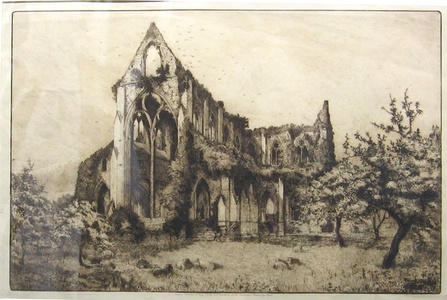| Method | Etching |
| Artist | Edward Slocombe |
| Published | London Published 1st July 1886 by Rob.t Dunthorne at the Rembrandt Head in Vigo Street |
| Dimensions | Image 325 x 494 mm, Plate 382 x 537 mm |
| Notes |
A large Victorian etching of the ruined Cistercian Abbey at Tintern, Monmouthshire. The great abbey church and the chancel are depicted in their ivy-clad ruinous state, and a flock of sheep graze and rest in the foreground. Like many of the religious buildings across England and Wales, Tintern was abandoned during the Dissolution of the Monasteries. It lay in ruin for the next two centuries before becoming a favourite muse for poets and artists. Its fame was brought to the fore by the publication of the Reverend William Gilpin's Observations of the River Wye (1782), the seminal work on the aesthetic of the 'picturesque.' Since Gilpin, the Abbey has served as a source of inspiration for Wordsworth, Alfred Lord Tennyson, JMW Turner, Allen Ginsberg, and even Iron Maiden. Tintern Abbey was held in special reverence by the Romantic poets, following Wordsworth's publication of Lines composed a few miles above Tintern Abbey. The poem was the last in a collection published by Wordsworth and Coleridge in 1798 in Lyrical Ballads, a work commonly accepted as beginning the British Romantic movement. Wordsworth's poem mused on themes of collapse, the lapse of time, and, critically, the personal and philosophical engagement between man and nature. These classic themes came to typify the Romantic aesthetic. Edward Slocombe (1850 - 1915) was born in London and part of a noted family of artists. Slocombe was a painter, etcher and mezzotint engraver. Some of his etchings were published in The Art Journal and the Portfolio, also a number of etchings of church bulidings were published by the Fine Art Society. Member of the RPE (Royal Society of Painter-Etchers |
| Framing | unmounted |
| Price | £250.00 |
| Stock ID | 5798 |

